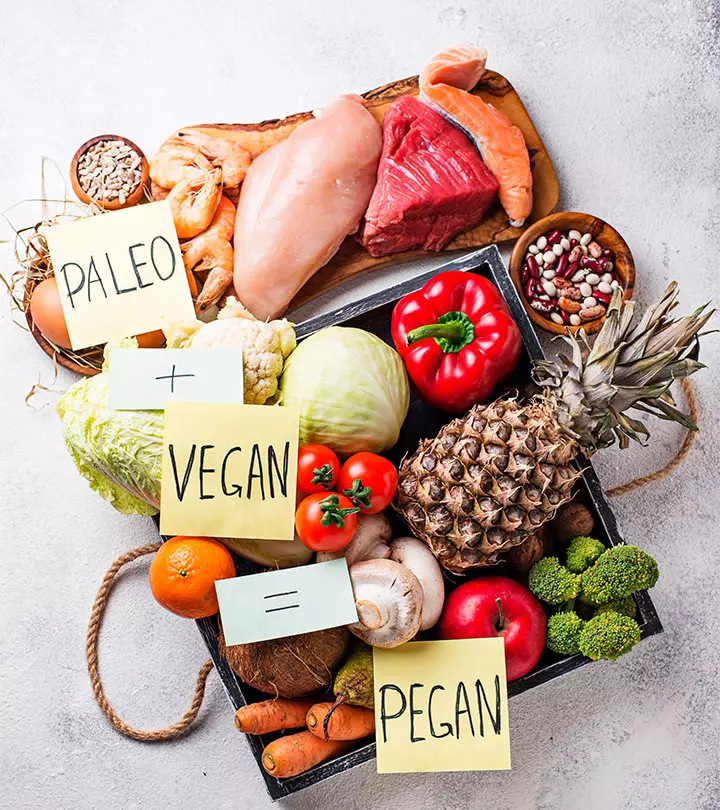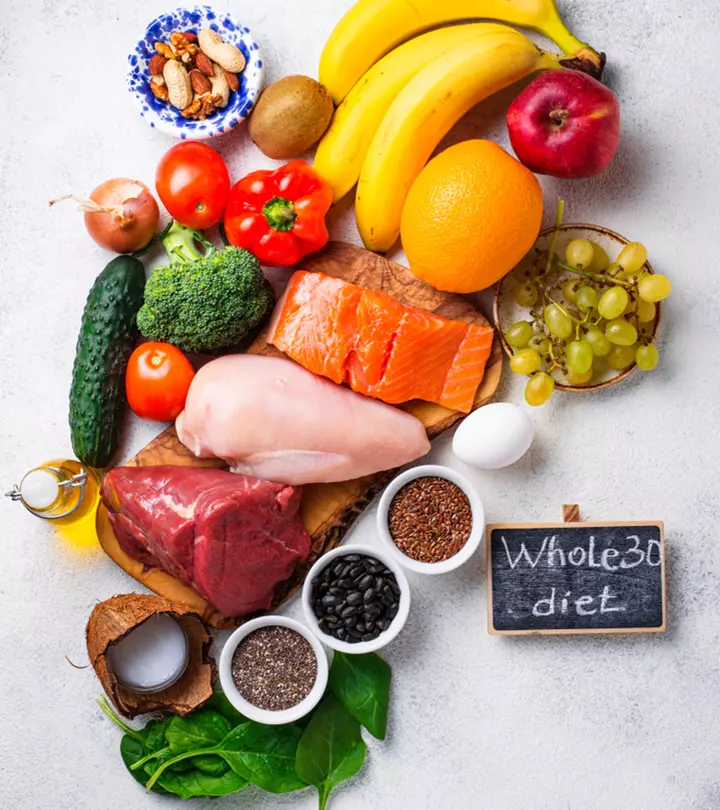Dukan Diet: 4 Phases, Food Rules, Benefits And Side Effects
Discover the potential health benefits, apart from weight loss, that this diet plan offers.

Image: Shutterstock
The Dukan diet has gained popularity in recent years for aiding effective weight loss. It is one of the easiest diets to follow due to its structured approach to weight loss. It involves the consumption of high-quality protein and low-carbohydrate foods. This diet was created in the early 2000s when its purported benefits started becoming popular. In this article, we look at the history of the Dukan diet, how it works, its phases, the foods to eat and avoid, its benefits, and possible side effects. Keep reading to know why so many people have turned to this diet plan despite there being so many other weight-loss diets and treatments available. Scroll down!

 At A Glance: Dukan’s Diet
At A Glance: Dukan’s Diet- Principle: A diet that focuses on including high-quality protein and limiting the intakes of carbohydrates and fats.
- Purpose: Weight loss
- Who It Is For: For those seeking a structured weight-loss diet with an emphasis on protein.
- Duration: Long-term
- Who Should Avoid: Pregnant or breastfeeding individuals and people with a history of) kidney problems or kidney stones.
- Cons: May get expensive and cause dry mouth, fatigue, constipation, headaches, nausea, nutritional deficiencies, and kidney stone formation.
In This Article
What Is The Dukan Diet?
The Dukan diet involves the consumption of high-quality protein foods while limiting the intake of carbohydrates and fats. High-protein diets not only reduce body weight but also improve body composition by reducing body fat. In addition to this, a diet that is high in protein can effectively speed up energy expenditure by increasing diet-induced thermogenesis (DIT)i The heat production in the body in response to food consumption. and resting metabolism (1). It also keeps you satiated for longer, so you don’t give into your hunger cravings. Intake of high-protein foods can also help preserve lean muscle massi The total weight of the body excluding the weight due to fat mass. (2). Much like the high-protein, low-carb diet, the Dukan Diet focuses on reducing carbohydrate intake while emphasizing protein-rich foods, which can boost metabolism and curb hunger.
This diet has been trending in many western countries for its effective and visible results. To learn more about the history of the Dukan diet, check out the next section.
History Of The Dukan Diet
The origin of this diet dates back to the 1970s. Dr. Pierre Dukan, a French doctor who practiced weight management, was consulting a patient with obesity who said that he could give up any type of food except meat (that is rich in protein). Dukan then formulated a diet plan that was high in protein and low in carbohydrates and fats. He has observed that many of his patients lost weight with this plan. He then published the book ‘The Dukan Diet’ in 2000, which was a major bestseller in 32 countries. Many people have claimed that they lost weight without experiencing hunger by following this diet.
The Dukan diet follows a structured approach with a special emphasis on a few major nutrients and works in phases. Check out the section below to find out how it works.
Key Takeaways
- The Dukan diet is a structured weight-loss program created by Dr. Pierre Dukan in the early 2000s.
- It is a high-protein, low-carbohydrate, and low-fat diet.
- It has four phases (attack, cruise, consolidation, and stabilization) with gradual introduction of various food groups.
- It helps preserve lean muscle mass while effectively aiding in weight loss.
How Does The Dukan Diet Work?
The Dukan diet has four different phases in which various food groups are introduced gradually. Its high protein intake helps curb your appetite by decreasing the ghrelini A hormone produced in the stomach that regulates hunger. levels in your body that increase hunger. It also promotes satiety (feeling of fullness) by boosting diet-induced thermogenesis and blood amino acid concentration (1). Carbohydrates and calorie-dense fats are also restricted in the initial phases to create a calorie deficit. This encourages the body to utilize the stored fat for energy (through ketogenesisi A metabolic process by which the body converts the stored fat into ketones, which are used for energy. ), which leads to weight loss (1), (3).
The phased approach of this diet helps individuals stay focused and gives them a sense of achievement as they progress from one phase to the other. There is also a gradual reintroduction of foods, which is claimed to prevent rapid weight gain and allow for a more balanced and sustainable way of eating. In its final stage, this diet provides a set of rules that you need to follow to maintain the achieved weight loss.
Along with weight loss, the Dukan diet also offers many other benefits. Check them out in the following section.
Benefits Of The Dukan Diet
- May Improve Blood Sugar Control

The Dukan diet may help improve blood sugar control. This can be attributed to the high-quality protein included in the diet plan that may lead to lower blood glucose levels (4). However, more research is needed to determine the long-term effects of this diet on blood glucose levels.
- May Improve Bone Health
A higher intake of protein may significantly increase intestinal calcium absorption and improve bone health in the long run (5). It also increases the insulin-like growth factor levels (IGF1), a key mediator in bone health. Protein also increases muscle mass and bone structure and strength (6).
- May Improve Skin Health

Foods rich in proteins contain amino acids that are vital for collagen synthesis. Collagen is essential for maintaining skin elasticity and health. Collagen peptides are proteins that enter blood circulation after digestion. They aid collagen and hyaluronic acid synthesis in the body and protect the skin from inflammation and aging caused by oxidative damage (7). Hence, a protein rich diet may improve skin health.
 Pro Tip
Pro TipReaping all these benefits of the Dukan diet requires you to follow this diet diligently. Learn more about what that entails in the next section.
4 Phases Of The Dukan Diet
This diet is structured into two weight loss stages and two maintenance phases. In all the phases, you need to consume a certain amount of oat bran to aid bowel regularity.
1. The Attack Phase
During this initial phase, the primary focus is on the consumption of lean protein-rich foods. The idea is to ignite your weight-loss journey by kick-starting the metabolism process with protein, while curbing calorie intake by avoiding carbohydrates and fats. In this phase 1.5 tablespoons of oat bran must be consumed daily.
This phase lasts approximately for 7-8 days. However, it varies based on your individual weight-loss objectives. If you have a substantial amount of weight to shed, this phase may be longer, but for those with more modest goals, it can be shorter.
2. The Cruise Phase
In this phase, the major objective is to achieve gradual weight loss by consuming lean protein along with non-starchy vegetables. It involves a rotation system that alternates between pure protein days and days when protein is combined with non-starchy vegetables. This phase continues until one successfully reaches their target weight. It is like a bridge connecting the initial rapid weight loss phase with a more sustainable, steady pace of weight reduction. Here, 2 tablespoons of oat bran must be consumed daily.
This phase can last anywhere from 1 to 12 months.
3. The Consolidation Phase
The key objective in this phase is to prevent weight regain with a gradual reintroduction of an extensive variety of foods like fruits, whole grains, and some occasional celebratory treats. This phase effectively balances weight maintenance and diversifying the diet, allowing one to enjoy a broader spectrum of foods while reducing the risk of quick weight regain. Here, 2.5 tablespoons of oat bran must be consumed daily.
The duration of this phase is calculated at 5 days for every pound lost.
4. The Stabilization Phase
In the stabilization phase, you can enjoy a wide variety of healthy foods while the lost weight remains constant. However, there are some rules you must follow to avoid regaining weight. First, you must eat all-protein meals for a whole day in a week. Second, you should exercise regularly to keep the lost weight off. A 20-minute walk every day can be a good option to start with. If you prefer, you can include various workouts to stay physically active. Also, opt for mindful eating to pay close attention to what you eat. It also helps reduce overeating. In this phase, 3 tablespoons of oat bran must be added to the daily diet.
 Did You Know?
Did You Know?Before starting the Dukan diet, it is recommended to prepare for it to stick to the plan and achieve better results. You can do it by following the instructions listed in the section.
How To Prepare For The Dukan Diet?
- Understand the concept and principles of this diet properly. Read Dr. Pierre Dukan’s books that explain this diet plan in detail.
- Fix your weight-loss goals so the plan can be tailored to your specific needs.
- Before starting this diet, consult a healthcare professional or dietician. They can help you customize your diet plan according to your health condition and dietary restrictions.
- To adhere strictly to the diet plan, remove any junk food from your home to minimize temptation.
- It is recommended to stock up on healthy groceries to ensure a smooth weight-loss journey.
- It is advised to have a meal plan prepared in advance for easy meal preparation every week and proper adherence to the diet.
- Consider taking supplements as per your needs (with the recommendation of a healthcare professional) to combat nutritional deficiencies.
In addition to these tips, you must know what the major foods to include in the Dukan diet are to make a proper meal plan. Check out the section below to know what foods you can eat while on this diet.
What Foods Should You Eat On The Dukan Diet?

- The Attack Phase
High-protein foods like skinless poultry (chicken, turkey), lean cuts of beef, pork, veal, cod, haddock, sole, eggs, tofu, tempeh, deli meats, and low-fat yogurt or cheese.
- The Cruise Phase
Lean meats, sea food, eggs, non-fat dairy, and spices. You can add non-starchy vegetables to your meals on alternate days. These include spinach, lettuce, cucumber, tomato, and zucchini. Avoid starchy vegetables like potatoes and corn.
- The Consolidation Phase
Protein sources like skinless poultry, lean cuts of beef, pork, veal, fish, seafood, eggs, tofu, and tempeh. In addition, reintroduction of starchy vegetables like peas, carrots, and legumes can be done in this phase. Fruits, cheese, and grains can be added too. However, moderation should be maintained.
- The Stabilization Phase
Protein sources like skinless poultry, lean cuts of beef, pork, veal, fish, seafood, eggs, tofu, and tempeh. You can also include starchy vegetables like peas, carrots, and legumes. In addition, you can occasionally have treats in the form of dessert or your favorite food. However, avoid processed foods and remember that moderation is key.
Check out the next section to learn about which foods to exclude when you are on a Dukan diet.
What Foods Should You Avoid On The Dukan Diet?

- High-carb foods (bread, white rice, and white sugar)
- Fried foods
- Full-fat dairy
- Bacon
- Sausages
- Candy
- Sugary beverages
- Alcohol
- Processed foods
- White-flour pasta
- Egg noodles
- Canned fruits
- Candied or sweetened fruits
- Breakfast cereals
- Flavored yogurt
Do note that this list is not exhaustive. In addition, you should avoid drinking fruit juices that are low on fiber and steer clear of beer as it is high on carbs. Also, avoid mixing your drinks with sweetened syrups. You can also consume coffee and tea with or without milk, minus the sugar.
Now, let’s take a look at a sample diet plan for the Dukan diet for 7 days. Check it out!
7-Day Dukan Diet Meal Plan
In each phase of the diet, you should include 1.5 grams of protein per kilogram of your weight daily.
Note: This is a short-term version of the Dukan diet. It is only to give a rough idea of how this diet will look like and food combinations you can use.
| Attack Phase Consume 1.5 tablespoons of oat bran per day. | Day 1 Breakfast: Omelet (2-3 eggs) and a small serving of low-fat cheese Lunch: Turkey breast salad (85-115 g) Snack: Greek yogurt (150 g) with oat bran Dinner: Grilled shrimp (3-4 oz) Day 2 Breakfast: 2 scrambled eggs and smoked salmon (85 g) Lunch: Grilled chicken breast (100 g) Snack: Low-fat yogurt (150 g) with oat bran Dinner: Stir-fried lean beef (100 g) |
| Cruise Phase Consume 2 tablespoons of oat bran daily. | Day 3 Breakfast: Greek yogurt (150 g) Lunch: Tuna salad (85-115 g) with mixed greens Snack: Low-fat yogurt (100 g) with oat bran Dinner: Grilled chicken thighs (100 g) with steamed broccoli and cauliflower. Day 4 Breakfast: Smoked trout (150 g) with a sliced cucumber Lunch: Baked cod (100 g) with a side salad Snack: Cottage cheese (150 g) with oat bran Dinner: Lean ham (85 g) with sautéed zucchini and bell peppers Day 5 Breakfast: 2 scrambled eggs with spinach (1 cup) and tomatoes (1-2, medium-sized) Lunch: 3 salmon filets with a side of asparagus Snack: Cottage cheese (100 g) with oat bran Dinner: Lean pork chops (80 g) with roasted Brussels sprouts. |
| Consolidation Phase Consume 2.5 tablespoons of oat bran per day. | Day 6 Breakfast: Whole-grain oatmeal (150 g) with sliced strawberries Lunch: Quinoa salad with grilled chicken (85-115 g) Snack: A small serving of fruit Dinner: Grilled turkey burger (100 g) with a whole-grain bun and mixed vegetables |
| Stabilization Phase Consume 3 tablespoons of oat bran daily. | Day 7 Breakfast: 2 whole-grain toasts with an avocado and a poached egg Lunch: Whole-grain pasta (100 g) with tomato sauce and lean ground beef Snack: A small serving of oat bran with vegetables Dinner: A balanced meal of your choice, incorporating all food groups |
It is recommended to consult your physician or dietitian to get a personalized protein dosage based on your health condition and issues (if any).
 Did You Know?
Did You Know?Like any other diet, this diet also comes with a few side effects along with an array of health benefits. Check out the section below to know more.
Side Effects Of The Dukan Diet
- Increased Risk Of Nutritional Deficiencies
Due to severe restriction of various food groups, specifically in the first two phases, there is a high chance of vitamin and other nutritional deficiencies. A study conducted on women of various ages found that following the Dukan diet resulted in levels of vitamin C and folates in the body (8).
- Increased Risk Of Urinary Stone Formation

The high intake of animal proteins on the Dukan diet may increase urinary calcium and also decrease urinary citrate excretion, which increases the risk of urinary stone formation (9).
- Increased Risk Of Constipation

The Dukan diet includes foods that are very low in fiber. Low fiber intake is associated with higher risk of constipation (10).
Also, pregnant or breastfeeding women and people with a history of urinary stones or a history of kidney diseases should avoid the Dukan diet.
The Dukan diet is not only known for its effective results but also for the sustainable weight loss it offers. It is a high-protein, low-carbohydrate, and high-fat diet that offers a structured approach to weight loss. Additionally, it may help improve your bone health and control your blood sugar levels. However, if you have any underlying health condition, it is recommended to consult a healthcare professional before starting the Dukan diet to avoid any undesirable side effects.
Infographic: The 4 Phases Of The Dukan Diet
The Dukan diet is a structured weight loss plan that focuses on consuming high-quality protein and low-carbohydrate and low-fat foods. It is divided into 4 different phases to achieve gradual weight loss. Check out the infographic below for a brief review of these phases and what foods you can eat during each phase.
Some thing wrong with infographic shortcode. please verify shortcode syntaxFrequently Asked Questions
What should I do if I experience side effects?
If you experience any side effects, such as fatigue, constipation, or dizziness, while on the Dukan diet, stop the diet immediately and consult with a healthcare professional. These side effects could indicate that the diet is not suitable for you, or you may need to adjust your intake of certain foods.
What is the success rate of the Dukan diet?
The success rate of the Dukan diet depends on an individual’s initial weight, adherence to the diet, food choices, and hydration. However, many people who have followed this diet claim to have lost a significant amount of weight.
Which is better – keto diet or Dukan diet?
The choice between keto diet and Dukan diet depends on your dietary preferences and health goals. Keto is high in fat and very low in carbs, while Dukan focuses on high-protein and low-fat foods. The keto diet does not have as many food restrictions. Consider consulting a healthcare professional or nutritionist to determine which one is better for your specific needs.
Can you eat tuna on the Dukan diet?
Yes, tuna is a lean protein source. It can be incorporated into the Dukan diet. It is best suited for the attack and cruise phases when you require a lot of protein.
Can you eat chocolate on the Dukan diet?
No, chocolate is not allowed on the Dukan diet, specifically in the early stages of the diet, because of its high sugar and fat content. However, in the stabilization phase, eating it in very limited quantities occasionally is permitted.
Can you do intermittent fasting on the Dukan diet?
Yes, intermittent fasting can be coupled with the Dukan diet, but it is essential to meet the protein requirements and follow the Dukan diet’s principles while doing so.
Is ketchup allowed on the Dukan diet?
Ketchup is generally discouraged on the Dukan diet due to its sugar content. However, you can have homemade or store-bought sugar-free ketchup.
Is the Dukan diet safe?
The Dukan diet can be safe when followed as instructed, but it is essential to consult a healthcare professional before starting any diet, especially if you have an underlying health condition or dietary restrictions.
Can vegetarians or vegans follow the Dukan diet?
While vegetarians can follow the Dukan diet by focusing on plant-based proteins, it may not be suitable for strict vegans due to the heavy emphasis on animal proteins.
Is the Dukan diet suitable for people with medical conditions?
Individuals with medical conditions – especially kidney issues or a history of kidney stones – should consult their healthcare provider before starting the Dukan diet, as it may not be suitable for those with specific dietary restrictions or medical needs.
Oat bran is a mandatory food to eat when you are on a Dukan diet. Check out the video listed below in which Dr. Dukan explains why consuming it is essential when following his famous diet.
References
Articles on StyleCraze are backed by verified information from peer-reviewed and academic research papers, reputed organizations, research institutions, and medical associations to ensure accuracy and relevance. Read our editorial policy to learn more.
- Clinical Evidence And Mechanisms Of High-Protein Diet-Induced Weight Loss
https://www.ncbi.nlm.nih.gov/pmc/articles/PMC7539343/ - Dietary Protein And Muscle Mass: Translating Science To Application And Health Benefit
https://www.ncbi.nlm.nih.gov/pmc/articles/PMC6566799/ - Ketogenic Diet And Weight Loss: Is There An Effect On Energy Expenditure?
https://www.ncbi.nlm.nih.gov/pmc/articles/PMC9105638/ - An Increase In Dietary Protein Improves The Blood Glucose Response In Persons With Type 2 Diabetes
https://pubmed.ncbi.nlm.nih.gov/14522731/ - Metabolic Advantages Of Higher Protein Diets And Benefits Of Dairy Foods On Weight Management, Glycemic Regulation, And Bone
https://pubmed.ncbi.nlm.nih.gov/25757894/ - Dietary Protein Is Beneficial To Bone Health Under Conditions Of Adequate Calcium Intake: An Update On Clinical Research
https://www.ncbi.nlm.nih.gov/pmc/articles/PMC4180248/ - Diet and Skin Aging—From the Perspective of Food Nutrition
https://www.mdpi.com/2072-6643/12/3/870 - Assessment Of Food Intakes For Women Adopting The High Protein Dukan Diet
https://pubmed.ncbi.nlm.nih.gov/26024402/ - Fad Diets And Their Effect On Urinary Stone Formation
https://tau.amegroups.org/article/view/4026/5601 - Lower Dietary Fibre Intake, But Not Total Water Consumption, Is Associated With Constipation: A Population-Based Analysis
https://pubmed.ncbi.nlm.nih.gov/31087475/
Read full bio of Tracy Tredoux
Read full bio of Aparna Mallampalli
Read full bio of Ravi Teja Tadimalla

























Community Experiences
Join the conversation and become a part of our empowering community! Share your stories, experiences, and insights to connect with other beauty, lifestyle, and health enthusiasts.